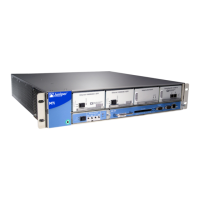Figure 3: Routing Engine Architecture
Routing Engine Functions
The Routing Engine handles all routing protocol processes, as well as the software
processes that control the router's interfaces, the chassis components, system
management, and user access to the router. These routing and software processes run
on top of a kernel that interacts with the Packet Forwarding Engine. For more information
about the processes, see the CLI Explorer.
The Routing Engine includes the following functions and features:
•
Processing of routing protocol packets—The Routing Engine handles all packets that
concern routing protocols, freeing the Packet Forwarding Engine to handle only packets
that represent Internet traffic.
•
Software modularity—Because each software process is devoted to a different function
and uses a separate process space, the failure of one process has little or no effect on
the others.
•
In-depth Internet functionality—Each routing protocol is implemented with a complete
set of Internet features and provides full flexibility for advertising, filtering, and modifying
routes. Routing policies are set according to route parameters (for example, prefix,
prefix lengths, and Border Gateway Protocol [BGP] attributes).
•
Scalability—The Junos routing tables have been designed to hold all the routes in
current networks with ample capacity for expansion. Additionally, the Junos OS can
efficiently support large numbers of interfaces and virtual circuits.
•
Management interface—Different levels of system management tools are provided,
including the Junos OS command-line interface (CLI), the Junos XML management
protocol, the craft interface, and SNMP.
•
Storage and change management—Configuration files, system images, and microcode
can be held and maintained in primary and secondary storage systems, permitting
local or remote upgrades.
•
Monitoring efficiency and flexibility—The router supports functions such as alarm
handling and packet counting on every port, without degrading packet-forwarding
performance.
7Copyright © 2019, Juniper Networks, Inc.
Chapter 1: System Overview and Architecture

